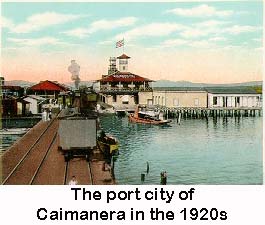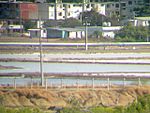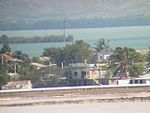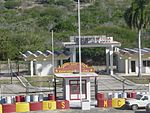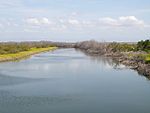Caimanera facts for kids
Quick facts for kids
Caimanera
|
|
|---|---|
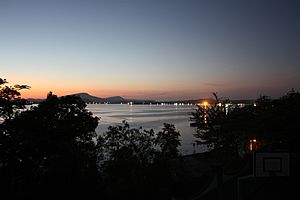
Guantánamo Bay at Caimanera
|
|
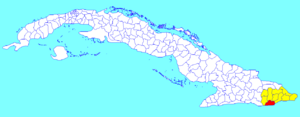
Caimanera municipality (red) within
Guantánamo Province (yellow) and Cuba |
|
| Country | Cuba |
| Province | Guantánamo |
| Area | |
| • Total | 366 km2 (141 sq mi) |
| Elevation | 5 m (16 ft) |
| Population
(2022)
|
|
| • Total | 11,273 |
| • Density | 30.80/km2 (79.77/sq mi) |
| Time zone | UTC-5 (EST) |
| Area code(s) | +53-21 |
Caimanera is a town and municipality located in Guantánamo Province on the southeastern coast of Cuba. It is a fishing village and port built on the west side of the calm Guantánamo Bay. The town is just north of the US naval base. It is about 34 kilometers (21 miles) south of the provincial capital, Guantánamo.
Contents
History of Caimanera
How Caimanera Got Its Name
The town was named after the caiman alligators. These crocodile-like animals were once very common in the local river and in the swampy areas of the bay. However, their numbers have since decreased.
Early Days and the US Base
In the early 1900s, Caimanera grew quickly. This was because of the construction of the nearby Guantanamo Bay Naval Base. Many Cuban workers came to Caimanera for jobs at the base. The town also became a popular place for visitors from other parts of Cuba and nearby countries like Jamaica.
Changes After the Cuban Revolution
Caimanera was freed on December 19, 1958. This date is often celebrated with a parade and special events in the town.
After the Cuban Revolution in 1959, relations between Cuba and the United States became difficult. This also affected the people of Caimanera and the nearby US naval base.
Before the revolution, US military staff from the base could freely visit Caimanera. The town had many places for them to visit. The base also employed over three thousand Cuban workers. These workers were taken to their jobs on the base by speed-boats.
After the revolution, both Cuba and the US made new rules. Cuba allowed workers to keep their jobs at the base. However, they had to walk to a remote entrance called the North-East Gate. The US decided to keep the Cubans who already worked there. But they would not hire any new Cuban workers. Over time, the number of Cuban workers slowly went down. The last two Cuban workers retired in 2012.
Recent Challenges in Caimanera
On May 7, 2023, some people in Caimanera protested because they did not have enough food. Train service to Guantanamo had stopped due to a lack of fuel. There was also no fuel for trucks to deliver food. This meant local stores were empty. Many residents could not travel the 34 kilometers (21 miles) to Guantanamo to buy food.
After the protests, the Cuban government took steps to manage the situation. They temporarily shut down the internet across the country. They also used a radio jammer to stop residents of Caimanera from using some wireless internet services.
Geography of Caimanera
Location and Borders
Caimanera shares its borders with other municipalities. These include Niceto Pérez, Guantánamo, Manuel Tames, and San Antonio del Sur. The area also includes smaller villages like Boquerón, Cayamo, and Mata Abajo.
The people of Caimanera live closest to the US naval base. The North East Gate, located near Boquerón, is the only border crossing point between the US and Cuba. Because it is so close to the US Base, Caimanera is considered a forbidden town (or zona militar). This means visitors need special permission from the government to enter.
Unique Bay Features
The upper part of Guantanamo Bay is a "pocket bay" (bahias bolsas). This means it has a narrow opening connecting it to the sea. Caimanera is located right on this narrow part, between the upper and lower sections of the bay.
Internet Access
Caimanera is unique in Cuba because it is within range of the T-Mobile cell towers at the naval base. This allows residents to get American cellphone and 4G internet service.
Population and Demographics
In 2022, the municipality of Caimanera had a population of 11,273 people. The total area of the municipality is 366 square kilometers (141 square miles).
Economy of Caimanera
Ships mainly export sugarcane and coffee from Caimanera. Fishing is no longer a major part of the economy. This is because most of the fish are found in the lower part of the bay, which is within the territory of the naval base.
Transportation in Caimanera
Caimanera is connected to Guantánamo by the "Carretera a Caimanera" road. This road is close to the main Cuban highway, the "Carretera Central". The town also has a train station on a smaller railway line that goes to Guantánamo. However, the train stopped running during the COVID pandemic because there was not enough fuel.
Gallery
-
Guantánamo River near Caimanera
See also
 In Spanish: Caimanera para niños
In Spanish: Caimanera para niños


